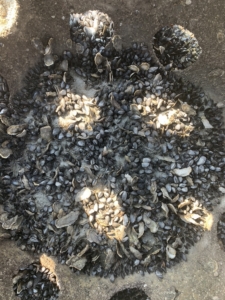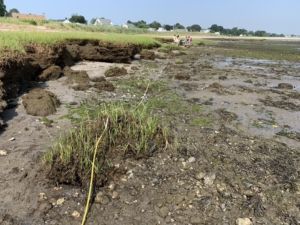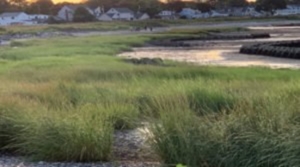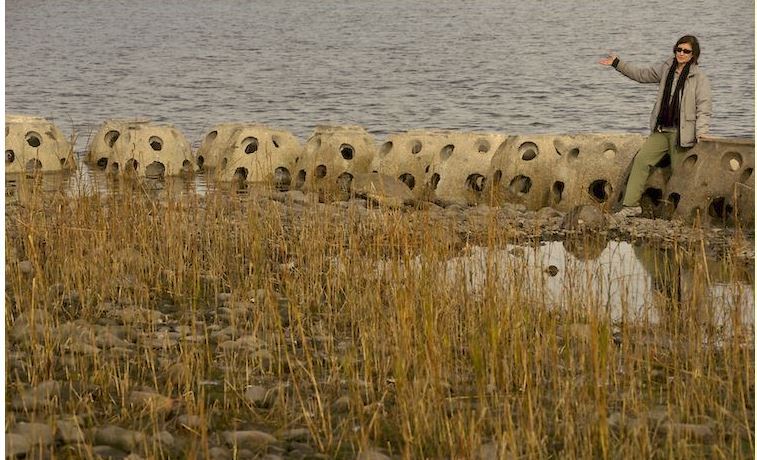Stratford Point Restoration
An Award Winning Project
Sources: Reef Innovations; Connecticut Audubon Society; Kim Swartz, HamletHub; CIRCA (Connecticut Institute for Resilience & Climate Adaptation (CIRCA) ; American Shore & Beach Preservation Association (ASBPA); Dr. Jennifer Mattei, Professor, Biology Department, Sacred Heart University; Long Island Sound Study

What Is A Living Shoreline?
A Living Shoreline consists of an artificial reef, sm
ooth cordgrass (Spartina alterniflora) marsh, high marsh, coastal dune and upland woody/grassland mosaics.
Stratford Point Living Shoreline, a research project headed by Sacred Heart University biology professor Dr. Jennifer Mattei, with members of her lab, is part of a peninsula in Stratford’s Lordship section, near the mouth of the Housatonic River. It comprises artificial “reef balls;” smooth cordgrass marsh; high marsh; coastal dunes and coastal forest/grassland mosaics. Its purpose is to establish a shellfish reef, establish natural protections against wave energy and disrupt coastal erosion.
What started in 2014 as a 150-foot research project —with support and participation from the landowner, Corteva Agriscience — has grown into the largest living shoreline in New England.
After restoration efforts resulted in more than a foot of sediment accumulation and marsh recovery, the project received grants from the National Fish & Wildlife Foundation, Connecticut Institute for Resilience and Climate Adaptation (CIRCA), the National Oceanic and Atmospheric Administration, and the U.S. Army Corps of Engineers Connecticut In-Lieu Fee Program which is sponsored by Audubon Connecticut. This funding allowed for expansion of the living shoreline, which now provides an additional 750 feet of coastal erosion control, 4.5 acres of intertidal habitat, 1.5 acres of coastal dune habitat and 25 acres of woodland/meadow mix.
Subsequent monitoring will provide additional understanding regarding the potential effectiveness of living shorelines as a means to increase coastal resilience and will inform future designs/guidelines for Connecticut and coastal communities in New England.

Background
In 2013 Connecticut Audubon Society and Sacred Heart University were awarded a $59,000 Long Island Sound Futures Fund grant to construct an innovative “living shoreline” at Stratford Point, to improve critical bird and wildlife habitat and protect the state’s coastline from storms like Hurricane Sandy. It was one of 23 Long Island Sound Futures Fund grants awarded by the National Fish and Wildlife Foundation (NFWF).
The Living Shoreline includes the construction of a reef consisting of permeable concrete reef balls—a technology that (at that time) had never before been used in Long Island Sound. In the Pilot study 64 reef balls were deposited, and the results were so good that we now have a total of 372 reef balls.
They look like strange objects from another planet, but the dome-shaped structures that were placed in the muddy waters off the Stratford Point shoreline offer more than a surreal view. They are helping to dissipate the energy from tidal waves. This artificial reef is being tested to see if it helps to prevent erosion along the shore and give newly planted salt marsh vegetation a chance to grow.
The reef balls were installed in April 2014 by a team of SHU and CAS staff and volunteers. The reef balls used are 1,000 pounds and 3 feet by 4 feet. Reef balls placed further out on Stratford Point 1,500 pounds, and 4 feet by 5 feet wide. These reef balls are set in place with tractors. Each reef ball—manufactured by the non-profit Reef Ball Foundation—has Swiss-cheese-like holes to allow water, tides, sediments and marine life to move in and out.
During storm events pressure sensors designed to measure wave energy were placed in front and behind the reef balls. The reef was found to have reduced wave energy by 30 percent, a significant help in not only preventing erosion, but in allowing for the accumulation of between one to six inches of sediment both behind and in front of the reef. For tidal areas, the ability to accumulate sedimentation is crucial in their ability to keep pace with sea level rise to prevent the salt marsh from becoming oversaturated and eroded.
Advantages of Living Shorelines
- They absorb rather than reflect wave energy, decreasing uneven and unnatural rates of erosion
- They complement the natural shape and aesthetic of the shoreline while honoring natural sand movement and coastline dynamics
- They create more stable shallow water habitat to support aquatic species
- They aid in filtration of sediments and pollution to improve water quality
- They can produce ease of shoreline access for wildlife
- Their costs may be proportionate to “structural” or “hard” shoreline management techniques
The living shoreline works by slowing down and breaking up waves and storm surges that cause erosion, allowing for sediment deposition and for protective tidal marsh plants to take root. It allows a natural community to emerge, providing habitat that acts as a fish and blue crab nursery and a hard substrate for shellfish settlement, and enhancing habitat for Great Egrets, Snowy Egrets, Black-crowned Night-Herons and other birds.
It will help protect the newly restored upland coastal habitats that Connecticut Audubon and Sacred Heart, which is in Fairfield, have undertaken at Stratford Point over the past four years. This project will greatly improve its value as a key bird and fish habitat in the heart of the Housatonic River estuary.
Living shorelines use a variety of structures and natural features, such as dunes, reefs and marshes, to protect fragile coastal features as well as shoreline property. These are in contrast to seawalls, rip-rap walls, bulkheads and other armoring structures which, at the expense of natural habitat, tend to harden and destabilize the shoreline, cause loss of beachfront and sever the biological link between the land and sea. Sea-level rise and increased storm intensity undermine sea walls. Storm waves engulf walls, and trapped water causes flooding. Walls erode and collapse, and reconstruction is costly. The solution, as Stratford Point Living Shoreline demonstrates, is to re-establish the missing habitat to protect the shoreline, hold the sediment and increase resilience.”
The reef balls allow sand and sediment to settle near the shore, creating habitat for tidal marsh grasses, which themselves provide habitat for estuarine animals and added protection for the shore. The reef balls become habitat for fish and lobsters
Nature-based solutions provide nursery habitats for commercially important fish species and shellfish that filter and clean the water at greatly reduced costs compared to armoring shorelines. The Stratford Point Living Shoreline is used as a model for other coastal communities, demonstrating the services gained by using nature-based solutions to erosion.
In 2020 the American Shore & Beach Preservation Association (ASBPA) awarded Best Restored Shores to Stratford Point Living Shoreline. Stratford Point was one of two designees by the ASBPA, and this is what they had to say about us:
Stratford Point Living Shoreline, Connecticut

The Stratford Point Living Shoreline is an outstanding example of how to work with multiple partners and nature to solve some of our most difficult human-caused coastal degradation problems. This project clearly demonstrates the importance of shellfish reefs in the protection of newly restored saltmarsh and their role allowing time for marsh migration to occur as sea levels rise and storms increase. Especially noteworthy were its well-characterized objectives, long-term monitoring plan that demonstrated success, and the multiple funding partners involved in taking the project from concept to execution that achieved real environmental and coastal resilience outcomes.
Dr. Mattei hopes the ASBPA (American Shore & Beach Preservation Association) award shines a light on the project and brings attention back to environmental issues in the U.S. “Climate change is not going away. Property owners need to get together and start revegetating and repopulating their shoreline with oysters and shellfish to protect their properties,” she said. “Ultimately, we need to be better stewards of Long Island Sound because it gives us so much in return.”
“Stratford Point is part of an Audubon Important Bird Area and it has been incredible to see saltmarsh, seaside, and Nelson’s sparrows in the re-established salt marsh habitat,” said Corrie Folsom-O’Keefe, director of bird conservation for Audubon Connecticut, a project partner. “The Long Island Sound ecosystem is critical to the health of birds and safety of coastal communities, and we need more projects like the Living Shoreline at Stratford Point to serve as models for success.”
Dr. Mattei and her team provide research experiences every summer for students enrolled in Sacred Heart’s new Coastal and Marine Science major, which explores solutions to the world’s ever-changing environmental challenges. “This new program will get students involved in coastal management and restoration to help preserve and enhance our coastal resources,” Dr. Mattei said.

